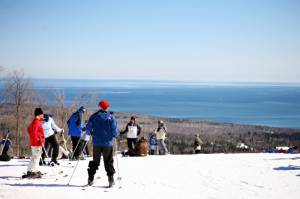Lutsen, MN – Lutsen ski resort, on Minnesota’s upper peninsula, has gained a variance from the state’s Department of Natural Resources (DNR) to draw snowmaking water from a nearby stream even though the drought-plagued stream has dropped below minimum flow levels.
DNR Commissioner Tom Landwehr on Thursday granted permission for Lutsen Mountains Corporation (LMC) to withdraw water from the Poplar River, a designated trout stream. Landwehr cited the potential economic impact upon Lutsen Mountain in explaining his decision.
Lutsen has been exceeding its permitted draw of the river’s water for years, reports indicate. Lutsen says that the alternative, a pipeline to draw water from nearby Lake Superior, is too expensive to be practical without an outside source of funding.

In response, Minnesota lawmakers passed a law allowing Lutsen to withdraw 150 million gallons per year, a ten-fold increase from the amount allowed by its earlier permit, and up to two million gallons per day, from the Poplar River, but included a provision that stopped the withdrawals in times of low water flow, and flows have remained below that minimum this fall. Fisheries experts argue that withdrawing water from the river during times of low flow will result in “anchor ice,” which reaches to the river bottom and kills fish. The law allows Lutsen to continue withdrawing water during times of low flow for “just cause.”
It’s that last provision that Landwehr relied upon in announcing his decision on Thursday.
“The Poplar River is not a long-term sustainable source of water for LMC,” Landwehr said. “We will work with LMC and key legislators to find an alternate source of water for snowmaking even sooner – probably Lake Superior – within three years.”
“This is a self-created problem that could have easily been avoided with better planning,” says Henry VanOffelen, Natural Resource Scientist with the Minnesota Center for Environmental Advocacy. “The ski resort has apparently built its business plan based on artificial snowmaking, but they have not made any plans to secure a sustainable supply of water. At their doorstep is the world’s largest supply of freshwater, yet the owners have chosen to de-water a trout stream rather than use the obvious alternative, Lake Superior. The state’s laws don’t allow a private corporation to wreck a public resource for private corporate gain.”
“DNR is setting a very bad precedent,” adds John Lenczewski, Executive Director of Minnesota Trout Unlimited. “The DNR is charged with protecting our public resources — resources that a large majority of Minnesotans recently voted to protect, restore, and enhance not dry up. The laws that protect these resources benefit all Minnesotans and apply to all Minnesotans equally – the DNR should not be in the business of granting special exemptions for private corporations to improve their bottom line.”
Lutsen’s new permit with the DNR requires the ski resort to find a new source of snowmaking water within three years. Lutsen Mountains Corp. president Charles Skinner is pressing the state to contribute to the estimated $2-3 million cost of building a pipeline to Lake Superior.

